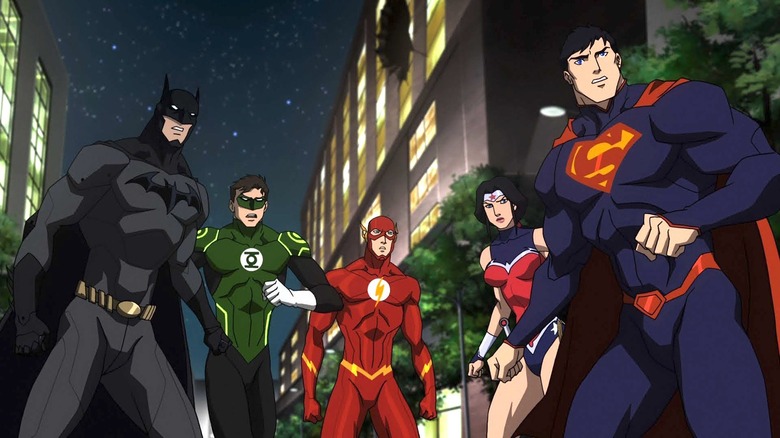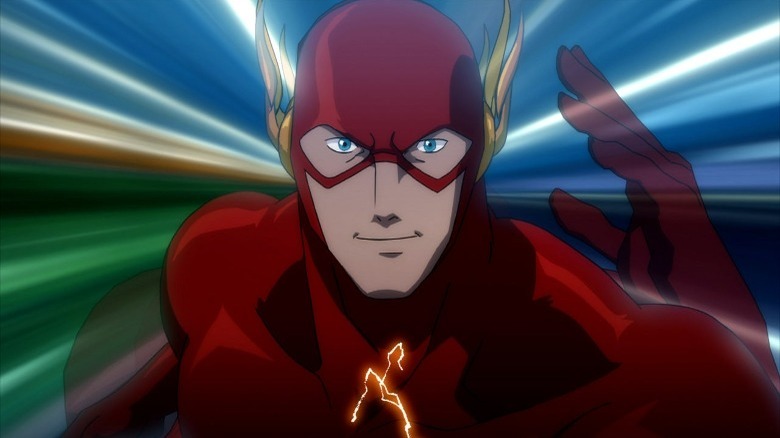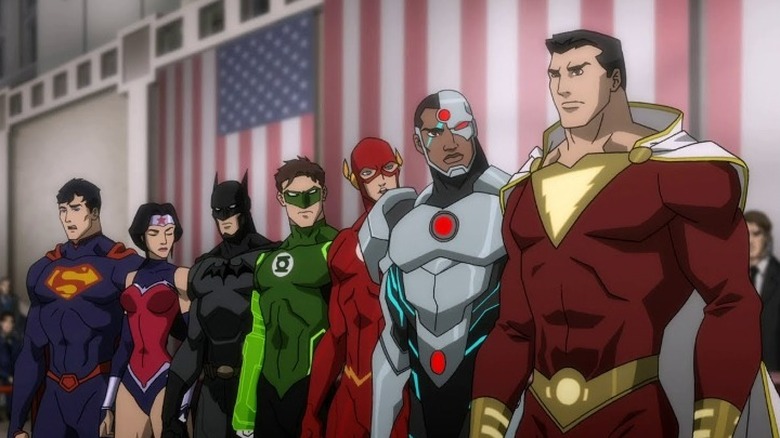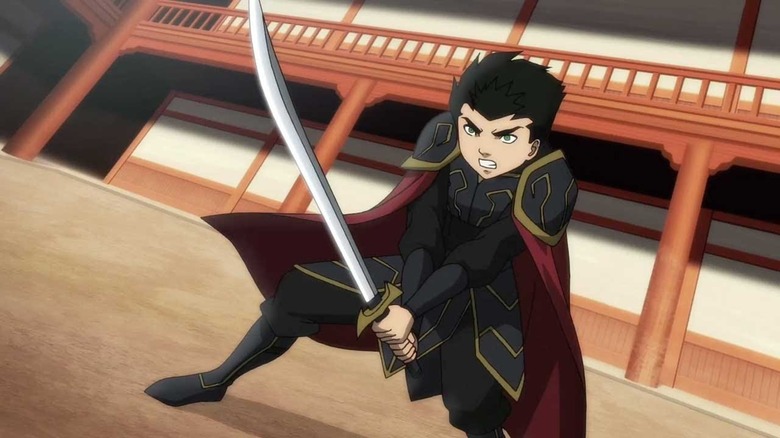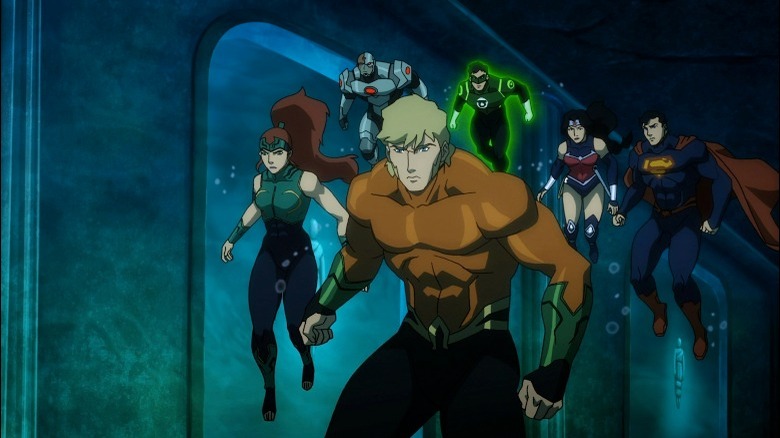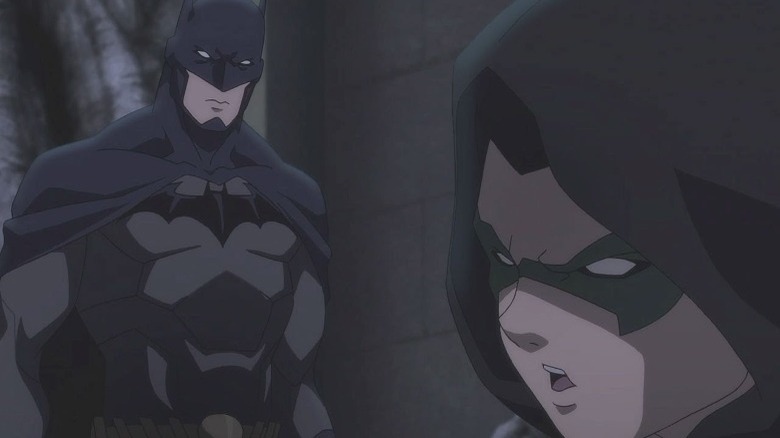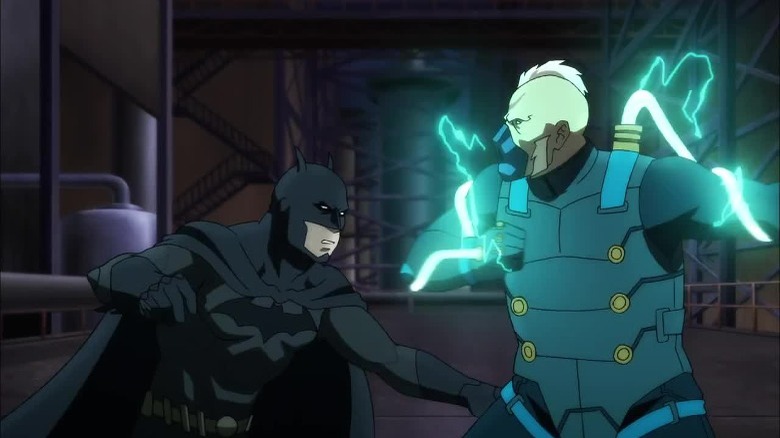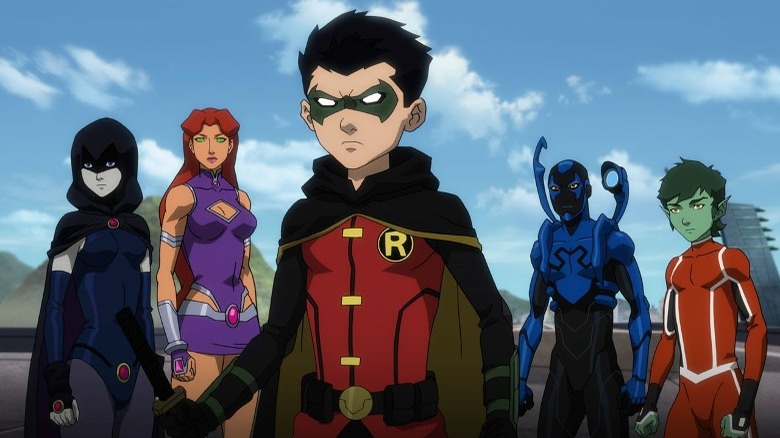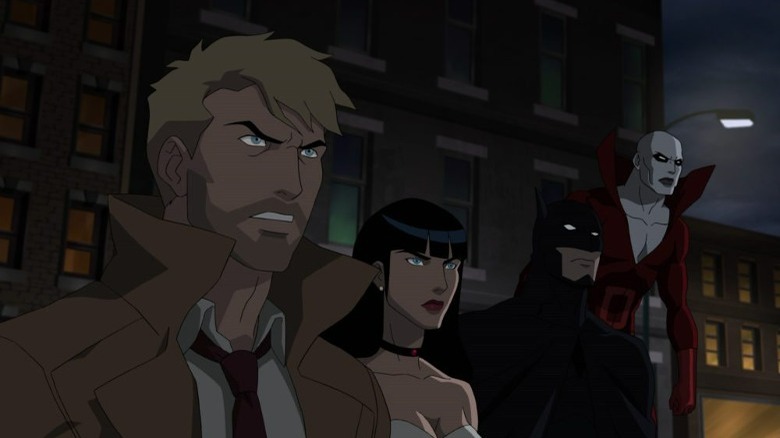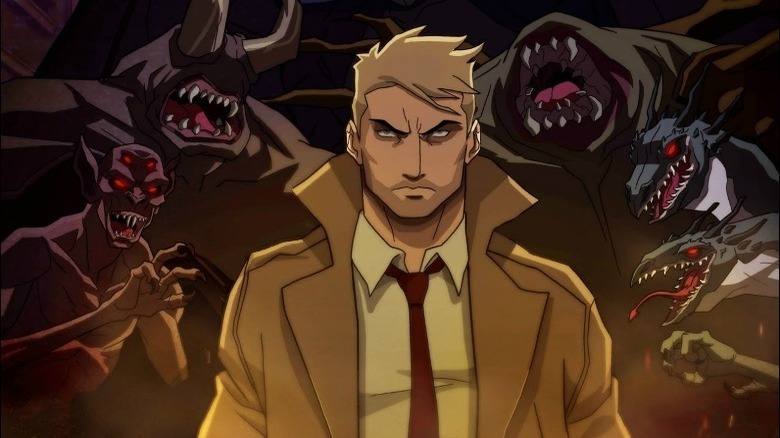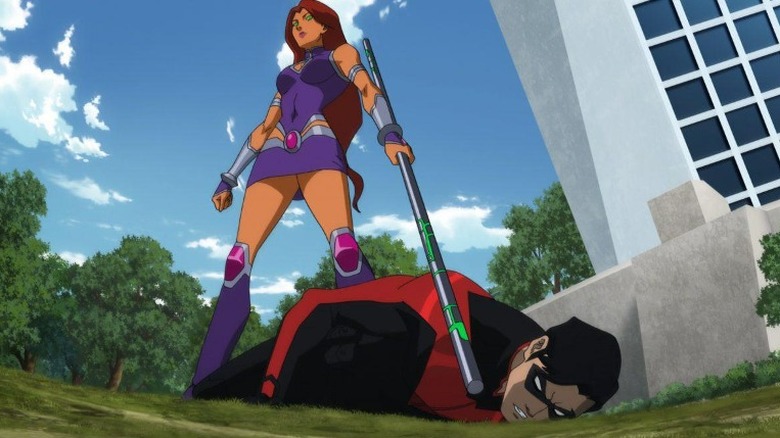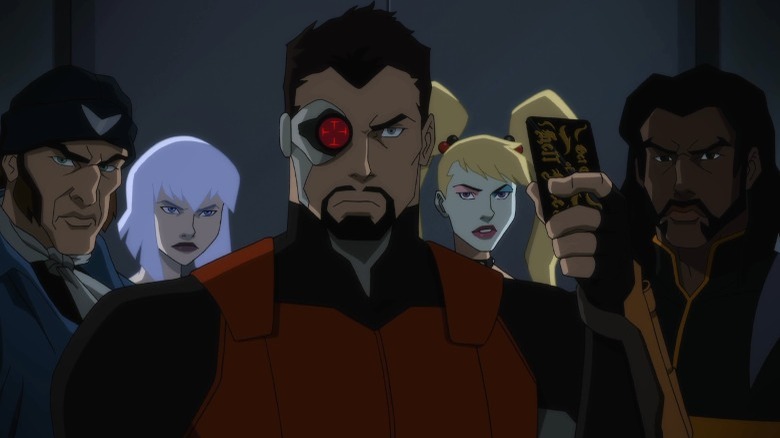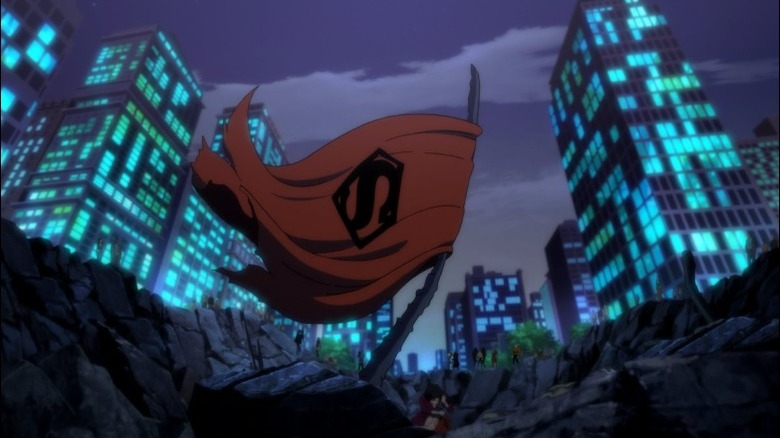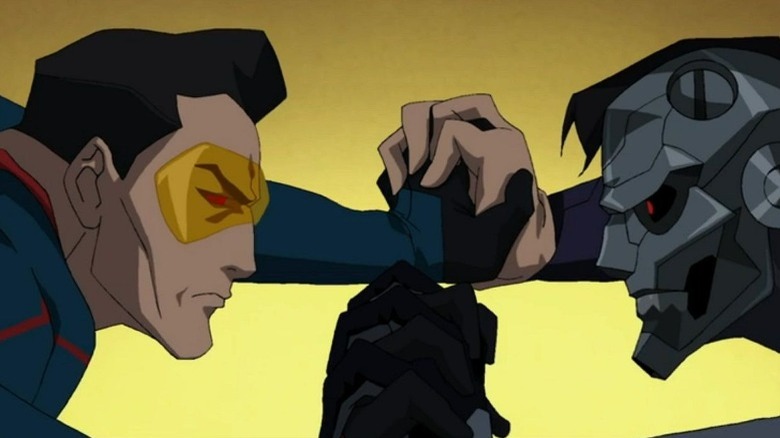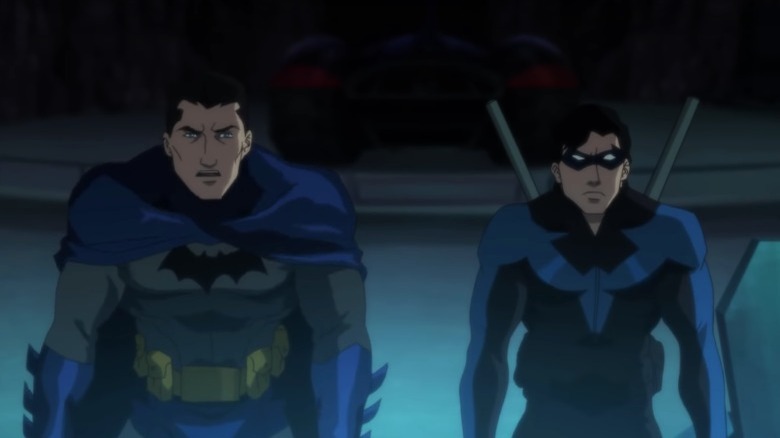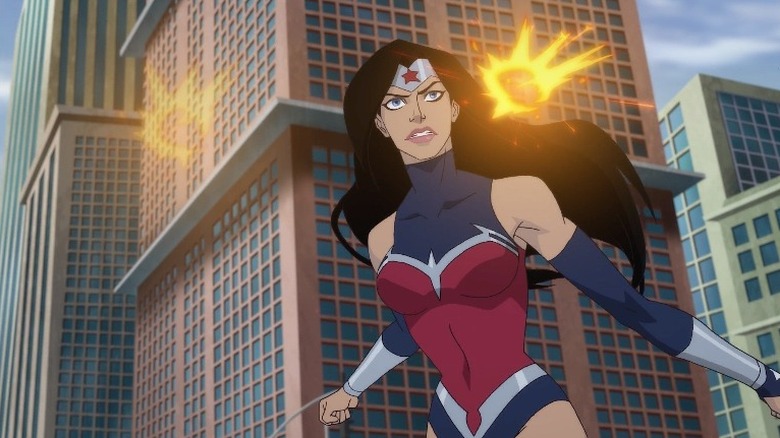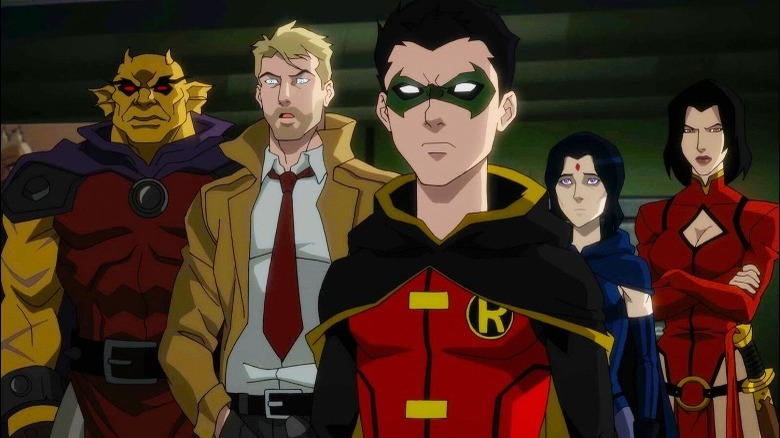The Correct Order In Which To Watch The DC Animated Movie Universe Movies
While it's difficult to deny that Warner Bros. hasn't had the best track record for releasing beloved DC Comics' live-action films via the DCU, the same cannot be said of animation. Since 1992, the studio has churned out dozens of animated films featuring the likes of Batman, Wonder Woman, Green Lantern, Superman, the Flash — and just about everyone else. What sets these films apart from their live-action counterparts is that most, if not all, are excellent.
DC Comics has dominated animation for decades, and in 2007, the release of "Superman: Doomsday" brought the grittier DC Comics universe to the masses. Many of these films are rated PG-13, so they're not aimed at a younger audience, which may have something to do with their success and adoring horde of adult fans. Most of the DC Animated Universe films are one-shots or two-part stories that don't fall into a broader universal narrative.
This changed in 2013 with the release of "Justice League: The Flashpoint Paradox," which launched the DC Animated Movie Universe. Unlike previous films, the DCAMU is a cohesive canonical universe, much like the Marvel Cinematic Universe, comprising 16 films. Now that they've all been released, seeing them in the correct order is essential. While you can, of course, go chronologically by release date, that's not necessarily the best way to watch the DCAMU. If you want to see the story from beginning to end in the best way possible, head to Max and watch them in this order.
Justice League: The Flashpoint Paradox
Because there were already numerous movies from the DCAU, the DCAMU had to set itself apart, and fortunately, the comics took care of it with 2011's "Flashpoint" crossover by Geoff Johns and Andy Kubert. That book kicked off a series revamp, and did the same for the animated films. "Justice League: The Flashpoint Paradox" took the best elements from the comics and used them to create a darker, grittier animated universe to explore new aspects of DC's most popular characters.
The film sees Barry Allen, otherwise known as the Flash, right a wrong that plagued him throughout his life: the death of his mother. Barry runs into the past and thwarts her murder, which completely upends the timeline. When he returns to the present, he finds himself in an entirely new world. The Justice League is far deadlier than before, and characters like Aquaman, Wonder Woman, and Batman don't hold back when the opportunity to take lethal action presents itself.
"Flashpoint Paradox" explores how the heroes Barry knew became people he no longer recognized, but it wasn't through any direct influence. Each person became who they were in the only reality they ever knew, and only Barry knew the difference. His mother's death turns out to be the lynchpin that separates his DC Universe from a much darker one, and putting things back the way they were isn't as easy as running into the past, because that would mean letting his mother die all over again.
Justice League: War
With the DCAMU set back into the original timeline, things return to normal, and "Justice League: War" picks up with an adaptation of Geoff Johns and Jim Lee's "Justice League: Origin." This was the first book that relaunched the DC Universe into the "New 52," and it serves as a retelling of the titular team's origin. It picks up immediately after the post-credits scene in "Flashpoint Paradox," which features a Boom Tube opening above Earth, spilling out a horde of Parademons.
Darkseid's invasion of Earth is on, and the only people remotely capable of stopping it aren't a team ... yet. The film sees Superman, Batman, Wonder Woman, Flash, Green Lantern, Shazam, and Cyborg unite to form the Justice League to stand up to Darkseid and his army of Parademons threatening the world. It's different from the original formation of the team all the way back in the 1960s, with "The Brave and the Bold" #28, but it does repeat some story elements previously found in the DCAU.
As a result, "Justice League: War" is very similar to the three-part premiere of 2001's "Justice League" television series. Despite this, "Justice League: War" serves as an excellent re-grounding of the DCAMU following the turbulent events of its predecessor. While it's possible to watch several films prior to this one, it's best to stick with this order, as the film does an excellent job of restructuring the primary heroes for the stories that follow it in the DCAMU.
Son of Batman
"Son of Batman" is an adaptation of Grant Morrison and Andy Kubert's 2006 story arc, "Batman and Son." The film introduces Damian Wayne to the DCAMU, and he's got an interesting family, to say the least. Damian's mother is Talia al Ghul, the daughter of Ra's al Ghul, so he didn't have what you might call a normal upbringing. Damian grew up learning the best ways to kill, and he's almost as efficient at what he does as his old man.
The film kicks off with Damian's grandpa shuffling off his mortal coil, thanks to Slade Wilson aka Deathstroke. Slade was upset that Damian was chosen to succeed his grandfather when he was his initial choice — so he did what members of the League of Assassins do, and killed his mentor. Talia drops the kid off with Batman, and the two don't exactly see eye to eye on things. Damian wants revenge, and Batman decides to make his son the new Robin to try and teach him discipline.
On the one hand, it's another Robin origin story, while on the other, it's a broadening of Batman's ever-growing Bat Family. More than that, it depicts the Dark Knight in a new light — who but Johns and Lee saw him as a father after years of endangering children? Regardless, the film's focus on Damian, who proves to be an important character in the DCAMU, helps audiences view Batman differently.
Justice League: Throne of Atlantis
"Justice League: Throne of Atlantis" is a loose adaptation of Geoff Johns' 2012-2013 "Throne of Atlantis" story arc from The New 52. Aquaman initially joined the Justice League in the team's first outing in the comics, but he didn't make his Justice League debut in the DCAMU until "Throne of Atlantis." The film focuses on Arthur Curry attempting to prevent a war between the Atlanteans and the surface dwellers.
For Aquaman fans, it's a familiar tale, and it all hinges around Aquaman's half-brother Orm, who adopts the mantle of Ocean Master. The film also serves as an origin story for Aquaman, as it focuses on Arthur discovering his true heritage. Since he knows both worlds, above and below, he is the perfect hero to bridge the gap and unite everyone. Of course, it won't be easy, especially while Ocean Master is in full command of the Atlantean army.
You might notice some familiar plot elements if you watched Jason Mamoa's 2018 film "Aquaman." There's a good reason for that — the screenplay was heavily influenced by The New 52's "Aquaman" series written by Johns. In addition to providing many of the story elements, Johns is credited as a writer for the film, so there are numerous similarities. Despite this, "Throne of Atlantis" stands out through its beautiful animation and brilliant cast, which includes Matt Lanter in the titular role, Sam Witwer as Ocean Master, and many talented players from the DCAMU.
Nightwing and Robin - Batman vs. Robin
"Nightwing and Robin" is a 45-second short set during the events of "Throne of Atlantis," so check it out before moving on to the next film, "Batman vs. Robin." The movie serves as a direct sequel to "Son of Batman" and occurs immediately after the events of "Throne of Atlantis." While the film focuses on the relationship between father and son (Bruce Wayne and Damian Wayne), it moves their story further along by introducing one of the Dark Knight's most dangerous villainous organizations: The Court of Owls.
The film is based on Scott Snyder, Greg Capullo, and Jonathan Glapion's "Batman: The Court of Owls" saga from 2012, and while it deviates somewhat, it's mostly faithful to the source material. The film opens with the Dollmaker, who is voiced by none other than Weird Al Yankovic. Batman is captured by the Court, only to be offered membership, which he politely declines. Damian doesn't make the same decision, and after butting heads with the Bat, he heads out to become a Court assassin.
Seeing as the League of Assassins trained him from birth, this isn't much of a surprise, but it does pit Batman against the Court. Ultimately, Damian takes center stage against the organization in an event that leaves the young hero traumatized. There are deep story elements in "Batman vs. Robin," forcing Damian to reevaluate his mantle as Robin and ultimately leave Wayne Manor to find himself.
Batman: Bad Blood
"Batman: Bad Blood" is the last Bat-centric film in the DCAMU until close to the end, and it serves to develop the Bat Family by focusing on its many members. The film is somewhat based on Grant Morrison's time penning the "Batman and Robin" comic book series in 2009. It focuses primarily on the story arcs dealing with Leviathan, an offshoot of The League of Assassins run by Talia al Ghul. "Bat Blood" picks up six months after the events of "Batman vs. Robin" and begins with Batwoman taking on a plethora of bad guys.
Batman arrives on the scene and confronts the leader, Heretic. The Dark Knight is seemingly killed by an explosion, leaving the many members of his Bat Family to fill the void left by the Caped Crusader. This brings Dick Grayson (Nightwing) and Damian back to Gotham, where Dick has assumed the mantle of Batman in his former mentor's absence. Of course, Batman isn't truly dead: He's being held by Talia, who tasks the Mad Hatter with brainwashing him for a plan to take over the minds of the world's leaders.
Ultimately, the Bat Family comes together and takes on Talia and her goons. The film is an excellent portrayal of the people closest to Batman, and while it stands well on its own, "Bad Blood" doesn't fit as well within the DCAMU. While Batman, Robin, and Nightwing remain important to the franchise following this film, the other members of the Bat Family don't feature as prominently.
Justice League vs. Teen Titans
The Teen Titans have been well-represented in animation, thanks to their inclusion in multiple television series. But outside of those shows and the films they spawned, the team didn't get a more adult adaptation until "Justice League vs. Teen Titans." The clearest distinction between those various properties and this film is the inclusion of Damian Wayne as Robin. While the character was seen in "Young Justice," he's much better represented in "Justice League vs. Teen Titans."
The film is an original story not based on any specific comic book series that came before its release. Despite this, it takes many elements of the characters from the comics and other sources, so it's a familiar tale, despite its originality. In the film, Damian is sent to work with the Teen Titans, having disobeyed his father. At first, he doesn't mesh well with his new team, but this changes fairly quickly. Meanwhile, the Justice League is overtaken by demonic entities, leading to the eponymous battle.
The corrupted members of the League beat the snot out of the kids, and Raven, who is the focus of the demonic incursion, goes with Superman to the desert. Ultimately, Damian has to use a Kryptonite blade against the Man of Steel to free his mind, and Raven steps in with her magic to quash the threat. It's a fantastic story in a film featuring tons of action, and it serves to move Damian's narrative forward, maturing him alongside his new team.
Justice League Dark
Your typical DC superhero is all about fighting for justice in the light of day. Of course, that's not all there is, and a dark underworld exists within DC Comics that includes demons, witches, wizards, and other magical entities. "Justice League Dark" brings this separate element of the DC Universe into the DCAMU. At the head is everyone's favorite British sorcerer, John Constantine, voiced by Matt Ryan in a reprisal of his role in the short-lived live-action "Constantine" TV series.
He's joined by Batman, Zatanna, Deadman, Jason Blood, Black Orchid, and Swamp Thing. The group bands together to find who — or what — is responsible for a series of magical attacks. This leads them to the House of Mystery and Ritchie Simpson, an old friend of Constantine who is under the influence of the Dreamstone, which he is using to keep his cancer in remission. Ultimately, he succumbs to the Dreamstone, releasing Destiny, and Justice League Dark is left to fight Destiny to save the world.
"Justice League Dark" takes elements from several comics, but is an original story. It also fits nicely into the DCAMU continuity by bringing magic into the mix somewhat early on. The film opens Justice League membership to Zatanna and Constantine (who declines). Ultimately, the film elevates the themes of the DCAMU to more adult-oriented fare, truly broadening the franchise's appeal and establishing it as a serious cinematic series with fantastic stories to tell.
Constantine: City of Demons
Unlike the other entries in the DCAMU, "Constantine: City of Demons" wasn't initially a feature film. It began life as an animated web series consisting of five episodes. A second half was later completed, and it was all compiled into a single feature-length film, which fits into the timeline immediately after "Justice League Dark." The film brings back Matt Ryan as Constantine and is loosely based on Mike Carey and Leonardo Manco's 2005 "Hellblazer: All His Engines." The film is much closer in tone to the original Vertigo "Hellblazer" books.
In the movie, Constantine is recruited by his old buddy Chas to help his daughter, Trish, who has fallen into a coma. Chas rightfully suspects dark magic, and Constantine learns Trish's soul isn't in her body, so he heads to Los Angeles to find it. Constantine's story about the Newcastle Incident surfaces and it's as dark as a story can get — it's also what compels the occultist to action. Eventually, Constantine faces the demon responsible for everything, but defeating him will require the greatest sacrifice of all.
"City of Demons" is incredibly different from the rest of the DCAMU, but that's why it's such a remarkable entry in the franchise. It's entirely about Constantine and touches on the many themes that makes him such a compelling character through 300 issues of "Hellblazer." This film is a treat for fans of the comics and an excellent introduction to one of Vertigo's greatest characters.
Teen Titans: The Judas Contract
Ask a "Teen Titans" fan what their favorite story from the comics is, and you've got a good chance of hearing "The Judas Contract." From legendary creators Marv Wolfman and George Pérez, it serves as the basis for "Teen Titans: The Judas Contract," which is also a direct sequel to "Justice League vs. Teen Titans." This film isn't the first time Wolfman and Pérez's story has been adapted into animation: The story was adapted for the Cartoon Network series "Teen Titans," though it targeted a much younger demographic.
The film covers the comic well and focuses on Deathstroke's plan to kidnap the Titans and drain their powers. To this end, he recruits Terra to betray the team on his behalf. Her treachery is significant, to say the least, and it has a lasting impact on every member of the Teen Titans. Terra's betrayal is rewarded with Deathstroke double-crossing her, and the whole thing ends with one of the saddest moments in the entire franchise.
The film is also notable for being the final work of Miguel Ferrer, who expertly voiced Deathstroke, capturing his sinister nature. Another standout performance comes from Christina Ricci, who plays Terra. At the end of the film, Beast Boy appears on Kevin Smith's podcast, which essentially ties the DCAMU in with the View Askewniverse — who could have seen that coming?
Suicide Squad: Hell to Pay
While The Suicide Squad hasn't fared particularly well with audiences in live-action, you can't say the same for "Suicide Squad: Hell to Pay." In the troublesome team's one and only outing in the DCAMU, you get everything: Magic, monsters, a twist ending, and a connection to the conclusion of "The Flashpoint Paradox." In the film, Amanda Waller has come to the realization that she's Hellbound, so she tasks the Suicide Squad with finding a magical artifact that will ensure she sees the Pearly Gates when she kicks the bucket instead of Satan's ... well, you get the idea.
This version of the team includes many of the same characters from live-action: Deadshot, Captain Boomerang, and Harley Quinn, as well as Bronze Tiger, Killer Frost, and Copperhead. There's a group of bad guys opposing Waller's team, which includes Professor Zoom, Vandal Savage, Silver Banshee, and Blockbuster. Unlike the first live-action adaptation of the team, "Suicide Squad: Hell to Pay" doesn't shy away from some fairly significant deaths. Numerous DC Comics B-level villains pay the ultimate price in their attempt to aid or undermine Waller.
Many die retrieving the artifact, which is a literal "Get Out of Hell Free" card, and the film's events make it less desirable than Waller may think. "Hell to Pay" is another darkly-toned film in the DCAMU, and while the characters are pretty much one-shot bad guys in what amounts to an otherwise standalone movie, they managed to connect it beautifully to the franchise as a whole through the presence of Professor Zoom.
The Death of Superman
"The Death of Superman" is arguably one of the most important Superman stories ever told, and a massive publicity event during the early '90s. What's important about the comics is how they introduced a foe Superman could only defeat by giving it his all, up to and including his life. It's a momentous occasion, and it's been adapted to death, including 2007's "Superman: Doomsday," the first DC Universe animated original movie.
"The Death of Superman" required some adapting to fit within the narrative of the DCAMU, but it does so perfectly, especially in its portrayal of the Man of Steel. He's not a cold, distant being defined by his abilities — he's more akin to the Superman from Christopher Reeve's films. Whenever he can, he stops his fight with Doomsday to protect the people, which is a defining aspect of the Man of Steel's nature, and it was noticeably lacking in his live-action portrayal in the DCEU.
It's a story many know well, and the ending is given away with the title. Superman fights Doomsday and dies in the process. A funeral is held for the Last Son of Krypton, and he's remembered as a true hero. The film ends with post-credits scenes, showcasing the many Superman replacements set to appear in the direct sequel to this film.
Reign of the Supermen
It's safe to say that the death of someone like Superman leaves a bit of a hole in the superhero community. As you may expect, several folks attempted to fill it, and none are as good as the original. "Reign of the Supermen" is based on the comic arc of the same name, which is set just after "Funeral for a Friend." It focuses on four powerful beings who enter the scene, all exhibiting similarities to Superman, or even calling themselves by the same moniker.
There's John Henry Irons' Steel, an Iron Man-esque hero inspired by Superman to do good with his knowledge of weapons technology. Kon-El is Superboy, a clone of Superman whose powers differ from his progenitor in several ways. Cyborg Superman claims to be the real Superman back from the dead, and the Eradicator looks a lot like Superman, despite his weird glasses. Each character's story unfolds in the film, and some are more villainous than they appear.
"Reign of the Supermen" introduces a number of characters meant to fill the void left by Superman's death, and it's a story that needs telling as a transitional tale that links "The Death of Superman" to the films that follow. The film also sets up an oncoming battle with Darkseid, who knows that Superman's absence means taking Earth is going to be easier than it was previously.
Batman: Hush
Batman is back at the helm with another brilliant adaptation of one of his best comic book stories. "Batman: Hush" is based on the 2002 story arc of the same name from Jeph Loeb and Jim Lee. In the movie, Batman faces a foe who knows everything about him, pushing the Dark Knight to the very brink by targeting his nearest and dearest.
To combat the threat, Bats has to form an alliance with his on-again-off-again crush, Catwoman, and there's even a bit of tasteful PG-13 playtime in the movie, which sets it apart from most of the animated Batman fare of the 1990s and early 2000s. Regardless, the film focuses on Batman's struggle to identify this new villain, Hush, and how he knows so much about him.
The ultimate revelation is partly what sets the film apart from its source material, but it works well within the movie's narrative. While "Batman: Hush" is a good adaptation, it's not the greatest Batman film in the DCAMU — that honor is reserved for "Batman vs. Robin," which serves as a more loyal adaptation. Regardless, if you want to understand Batman's motivations in the DCAMU, be sure to watch "Hush" before moving on to the next film.
Wonder Woman: Bloodlines
"Wonder Woman: Bloodlines" is loosely adapted from elements of the DC Rebirth versions of several Wonder Woman characters, while also taking inspiration from the decades of "Wonder Woman" comics. The film is otherwise an original story, though fans of the 2019 live-action "Wonder Woman" film will notice some similarities. In the movie, Princess Diana rescues Captain Steve Trevor from a Parademon attack — yes, they're back, and you know who will follow.
Diana leaves Themyscira to protect man's world, and she and Steve head to Washington, D.C. The story picks up five years later, and Diana has adopted the name Wonder Woman as she fights to protect the people. Her actions inadvertently fuel the creation of several supervillains — a the risk you take by becoming a superhero. The film introduces numerous characters familiar to Wonder Woman fans, including Ferdinand the Minotaur, Cheetah, Giganta, and many others.
The film's story comes off as a very personal one for Diana, making it similar to the Batman movies of the DCAMU. As a result, "Bloodlines" is easily one of the best adaptations of Wonder Woman on screen, and that includes Gal Gadot's live-action take on the character. Both properties stand out, but "Bloodlines" serves as an ideal penultimate entry in the DCAMU as it gears up for the big finale that ties it all together from beginning to end.
Justice League Dark: Apokolips War
Darkseid's first attack on Earth failed, but that doesn't mean he won't try again. He does so in "Justice League Dark: Apokolips War," which is both the final movie in the DCAMU and the darkest. The film features nearly every character introduced in the previous 15 movies, and it doesn't hold back from — spoiler alert — slaughtering most of them. Yes, few are safe from an apocalyptic wave of Parademon attacks brought forth by Darkseid, so don't expect everyone to make it to the end of the movie.
The film is based on Geoff Johns' "Darkseid War" and Grant Morrison's "Final Crisis." It also incorporates elements of the "Futures End" storyline and several aspects of various properties. Essentially, it takes a lot of inspiration from a series of properties, uses the best bits, and produces something unique. The film opens with a failed attack on Apokolips, which sees most of the heroes of the Justice League and Teen Titans slaughtered or enslaved.
The story picks up two years later, and things are as dark as the title implies. It gets bad ... real bad. While the heroes are ultimately victorious, it's a pyrrhic victory. Surveying the damage, there's only one way to make things right, and it takes the DCAMU back to the beginning. Flash must run fast enough to reset the timeline, and while things won't be as good or better than they were before, they have a chance to do something different. That's how the DCAMU ends — with a new beginning.
